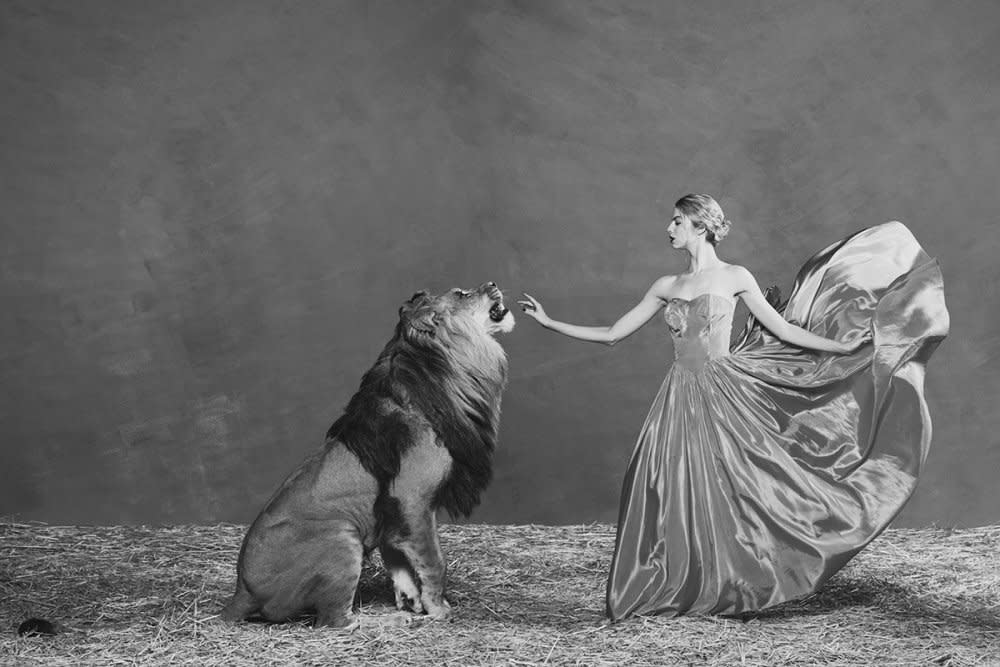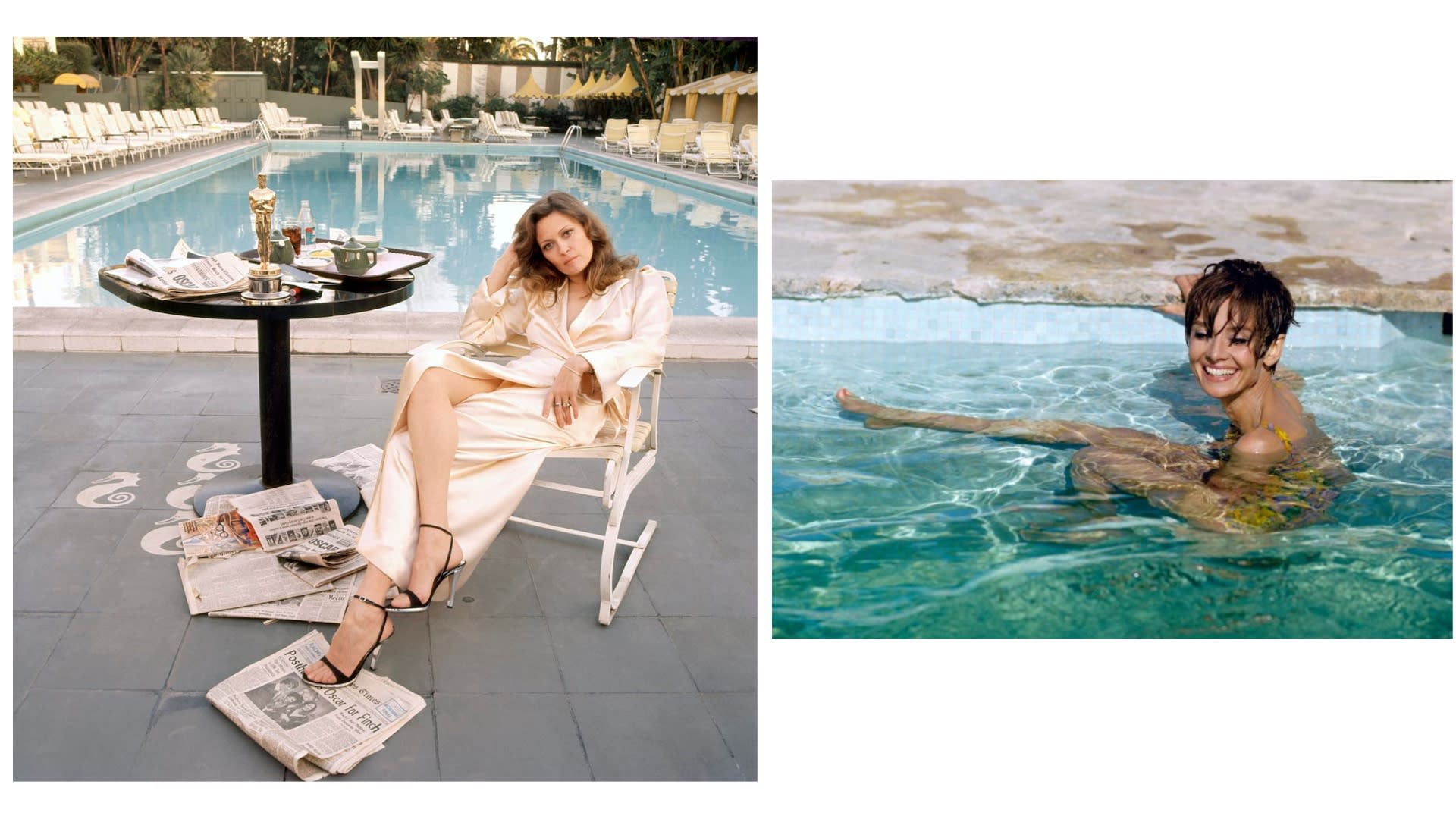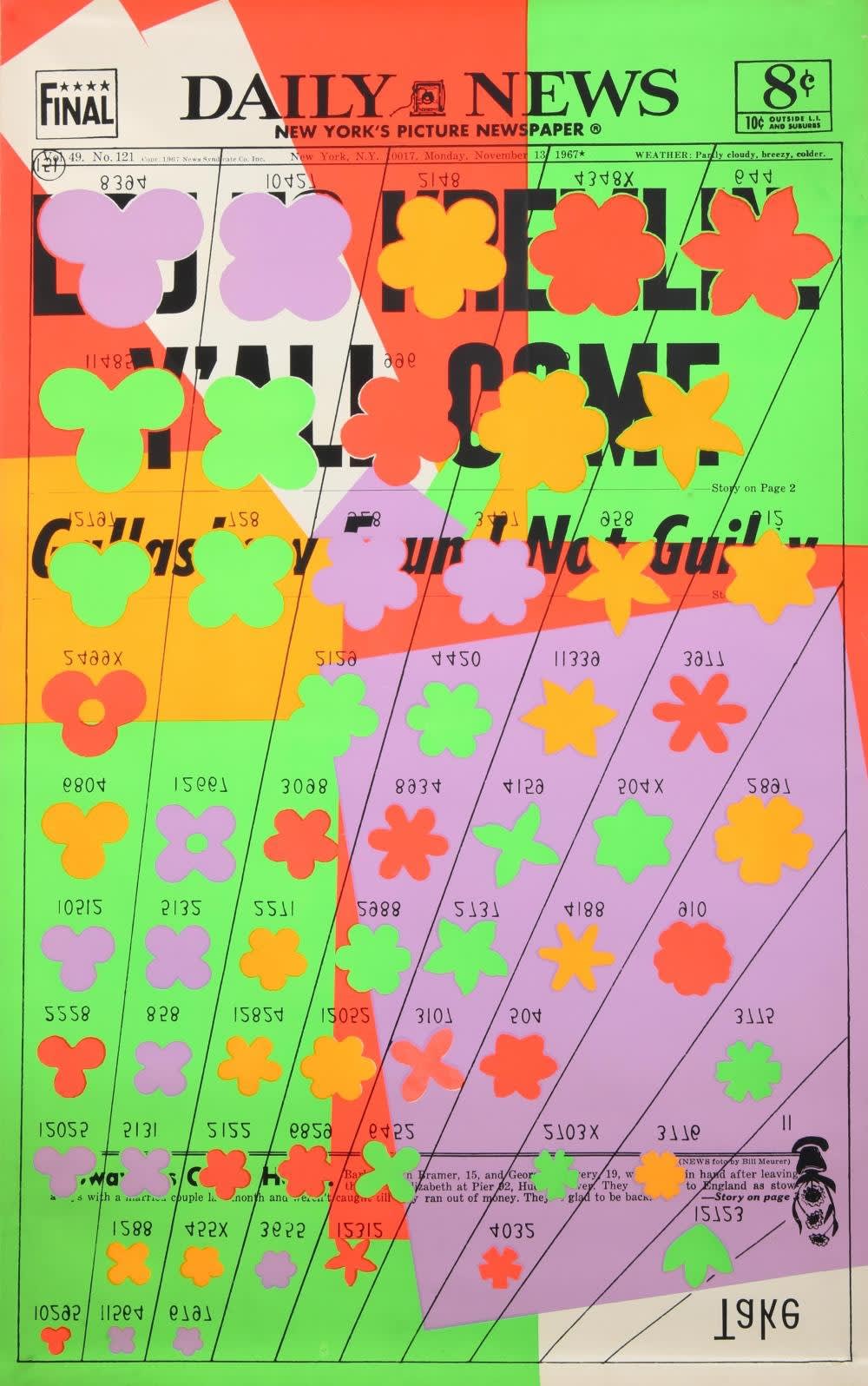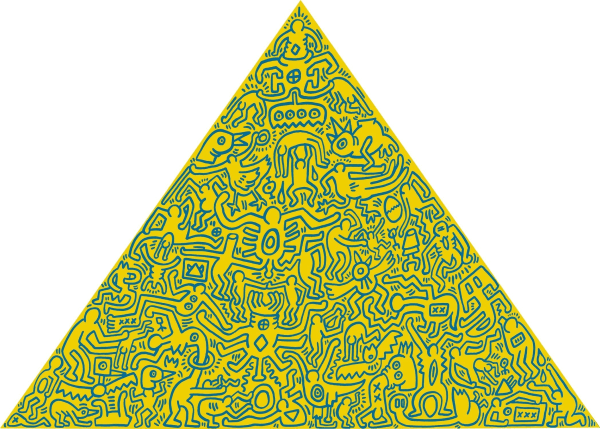
Keith Haring’s Pop Shop 6 Quad showcases the artist's iconic style and vibrant use of color. This silkscreen print, composed of four panels, captures Haring's distinctive blend of bold lines, energetic figures, and bright, eye-catching hues. Known for his ability to communicate powerful messages through deceptively simple imagery, Haring uses Pop Shop 6 Quad to explore themes of joy, movement, and community. The dynamic poses of the figures within each panel invite viewers into a world where art transcends barriers, fostering a sense of unity and connection.
Pop Shop 6 Quad is part of Haring’s celebrated Pop Shop series, a project aimed at making his art accessible to a broader audience. By opening the Pop Shop in New York City in 1986, Haring sought to democratize art, blurring the lines between high culture and everyday life. This piece reflects that mission, as it encapsulates Haring's playful use of visual language to address complex social and political issues. The vibrant colors and rhythmic patterns not only draw the eye but also echo Haring’s commitment to using art as a tool for social commentary and change.
Beyond its aesthetic appeal, Pop Shop 6 Quad is also a testament to Haring’s activism and his efforts to raise awareness about pressing social issues of his time. His work frequently addressed themes such as the AIDS epidemic and LGBTQ+ rights, and this piece is no exception. The interconnected figures symbolize solidarity and resilience, reminding viewers of Haring’s role as both an artist and an advocate. This piece allows us to celebrate Haring’s enduring legacy and engage with his art in a way that resonates with contemporary audiences.

Russell Young’s Mick Jagger, Reggie Kray Do You Know My Name, 2011, captures the intersection of celebrity, notoriety, and the allure of fame. This work features two iconic figures: Mick Jagger, the charismatic frontman of The Rolling Stones, and Reggie Kray, one half of the infamous Kray twins who dominated the London underworld in the 1960s. Through his signature silkscreen technique, Young juxtaposes the glamorous persona of Jagger with the gritty, criminal aura of Kray, creating a powerful dialogue about the nature of fame and infamy. The bold use of color and contrast emphasizes the duality of these public figures, highlighting the thin line between adulation and infamy.
Mick Jagger, Reggie Kray Do You Know My Name, 2011, is part of Young’s broader exploration of pop culture and its darker undercurrents. The artist is known for his provocative silkscreens that often delve into themes of excess, celebrity culture, and the American Dream. In this piece, Young draws on the mythos surrounding Jagger and Kray, two figures who, despite their different paths, both became icons in their own right. By placing them side by side, Young challenges viewers to consider how society glamorizes both rock stars and criminals, questioning the very nature of fame and the narratives we construct around it.
This artwork reflects Russell Young’s fascination with the visual and cultural impact of iconic figures. In Mick Jagger, Reggie Kray Do You Know My Name, 2011, Young focuses solely on Jagger, using his image to explore themes of identity and celebrity. The portrait, highlighted by its monochrome palette with a striking red accent on Jagger's lips, draws attention to the performative aspects of fame. Through this work, Young examines the enigmatic nature of fame and the blurred boundaries between the public and private selves of iconic personalities.

Tyler Shields’ Lion Queen is a striking photograph that captures a surreal moment of calm and control between a woman and a lion. Known for his provocative and often controversial imagery, Shields pushes the boundaries of traditional photography with this composition, blending elements of high fashion and wild nature. The image presents a powerful visual contrast: a poised, elegantly dressed woman stands in front of a lion, commanding its attention with a gentle hand. This juxtaposition creates a dynamic tension, emphasizing themes of power, beauty, and the primal instincts that lie beneath the surface of human civilization.
What makes Lion Queen particularly remarkable is Shields’ commitment to authenticity and the purity of his process. Unlike many contemporary photographers, Shields does not use any editing software; every image is captured in a single shot. This means that the woman and the lion were actually in close proximity during the shoot, adding a layer of real-life danger and bravery to the photograph. The fact that this dramatic interaction was achieved without digital manipulation makes the image even more impressive and underscores Shields' dedication to capturing genuine moments.
Beyond its aesthetic appeal, Lion Queen also invites deeper contemplation about the nature of human interaction with the animal world. The photograph is more than just a visually stunning image; it is a narrative about the potential for harmony between human elegance and animal ferocity. Shields’ ability to capture such a powerful and peaceful moment invites viewers to reflect on their own relationships with the natural world. Through this piece, Shields not only showcases his technical skill and creative vision but also his ability to evoke emotion and provoke thought.

Dylan Martinez’s collection of hand-blown glass water bags is a stunning example of how art can blur the lines between reality and illusion. At first glance, these sculptures appear to be simple plastic bags filled with water, but a closer look reveals that they are meticulously crafted from glass. Martinez's skill in manipulating glass allows him to mimic the delicate nuances of a filled plastic bag, from the subtle wrinkles to the small bubbles suspended within the water. This impressive trompe-l'oeil technique challenges the viewer’s perception, making them question the nature of what they are seeing.
The artistry behind Martinez's glass water bags lies in his ability to capture the fluidity and movement of water within a solid medium. Each piece in the collection showcases his expertise in glassblowing, a craft that requires precision, patience, and a deep understanding of the material. The sculptures are not merely imitations of plastic bags; they are a celebration of the craftsmanship and a testament to the artist's ability to transform an everyday object into a work of art. The realistic appearance of the glass sculptures, combined with their weight and texture, creates an intriguing juxtaposition between appearance and reality.
Beyond their technical mastery, Martinez's glass water bags also engage viewers on a conceptual level. The sculptures evoke thoughts about the environment, consumer culture, and the transient nature of modern life. By choosing to replicate a disposable plastic bag—a symbol of single-use consumption—Martinez invites reflection on the impact of plastic on our world. The permanence of glass as a medium contrasts sharply with the ephemeral nature of plastic, encouraging a deeper conversation about sustainability and the lasting effects of our choices. Through his art, Martinez not only captivates the eye but also provokes thought, making his collection a powerful addition to any gallery.

Andrew Orloski's metal basketballs are a unique exploration of materiality and transformation in contemporary sculpture. By casting these familiar objects in metal, Orloski challenges our perceptions of the commonplace and encourages viewers to reconsider the everyday items that surround us. The metal basketballs, with their intricate textures and detailing, maintain the recognizable form of a standard basketball, but the use of bronze—a material with deep historical and economic significance—elevates them to a new artistic plane. This transformation not only alters the physical properties of the object but also imbues it with new meaning, prompting reflections on the value and permanence of materials.
Orloski’s approach to sculpture is deeply rooted in his fascination with the natural world and the ordinary objects within it. His work often begins with a sense of juvenile wonder or admiration for a specific item, which then evolves into a conceptual exploration of how that object might change when its material is altered. In the case of the metal basketballs, this shift from rubber to bronze creates a striking contrast that speaks to the artist’s ongoing interest in the potential of materials to transform and convey new narratives. The choice of bronze, a material traditionally associated with classical sculpture and historical monuments, lends a sense of gravitas and timelessness to an object typically viewed as ephemeral and utilitarian.
The process behind Orloski’s metal basketballs is as significant as the final pieces themselves. Utilizing both traditional and contemporary mold-making techniques, Orloski meticulously casts each basketball, ensuring that every detail—down to the stitching and texture—is faithfully reproduced. This dedication to craft underscores his belief in the power of materiality and the ways in which different substances can shape the content and context of an artwork. Through his metal basketballs, Orloski invites viewers to engage with the familiar in an unfamiliar way, encouraging them to contemplate the intersections between form, material, and meaning in modern sculpture.

Terry O'Neill's Faye Dunaway At The Pool is an iconic photograph that captures the actress in a moment of reflective solitude, mere hours after winning the Academy Award for Best Actress in 1977. The image, taken at the Beverly Hills Hotel, depicts Dunaway in a silk robe, seated beside a pool surrounded by newspapers and her Oscar statuette, as she contemplates her achievement. O'Neill’s composition artfully juxtaposes the opulence of Hollywood success with the isolation that often accompanies it, creating a narrative that goes beyond the surface glamour. The morning light, soft yet revealing, adds a poignant layer to the photograph, highlighting both the triumph and the vulnerability of the moment.
In Audrey Hepburn in Pool, O'Neill captures the timeless beauty and elegance of one of Hollywood’s most beloved actresses. The photograph shows Hepburn, radiant and relaxed, leaning on the edge of a swimming pool, embodying effortless grace. The vibrant colors of the water and the natural light reflecting off the surface enhance Hepburn's joyful expression, creating a serene and inviting scene. This image is a testament to O'Neill's ability to capture the essence of his subjects, presenting Hepburn not as an untouchable star, but as a person in a candid, joyful moment.
Both of these photographs are exemplary of Terry O'Neill's talent for combining glamour with intimacy. Known for his portraits of celebrities, O'Neill had a unique ability to reveal the human side of the stars he photographed, often capturing them in unguarded moments. Through Faye Dunaway At The Pool and Audrey Hepburn in Pool, viewers are given a glimpse into the private worlds of these iconic figures, seeing them as real people rather than just screen legends. O'Neill's work is celebrated for its depth and authenticity, making these pieces not just photographs, but windows into the lives and personalities of two of Hollywood’s most enduring icons.

Andy Warhol’s Daily News screenprint is a striking example of the artist’s fascination with mass media and the commercialization of information. Created in 1976, this piece features a bold representation of the New York Daily News newspaper, capturing a moment in time while commenting on the pervasive nature of media in contemporary society. Warhol’s use of the screenprint technique, characterized by its mechanical reproduction and bold graphic style, mirrors the way newspapers disseminate information—quickly, repeatedly, and ubiquitously. By elevating a mundane object like a newspaper to the status of art, Warhol challenges traditional notions of what constitutes art and forces viewers to confront the everyday objects that shape their perceptions of reality.
The Daily News screenprint reflects Warhol's broader thematic focus on consumer culture and the blurring lines between high and low art. In the mid-20th century, Warhol became known for his innovative approach to art, where he transformed commonplace items into symbols of modern life. With this piece, he uses the familiar format of a newspaper, typically associated with the fleeting and disposable, and gives it permanence through his artistic process. The sharp contrasts and vivid inks used in the screenprint emphasize the bold headlines and layout of the newspaper, drawing attention to the sensationalism often inherent in media. This focus on the aesthetics of news production invites viewers to consider how the medium shapes their understanding of the world.
Daily News also serves as a reflection of Warhol’s commentary on the American obsession with celebrity and the consumption of news. As someone who was himself a subject of intense media scrutiny, Warhol understood the power of the press and its role in constructing public personas. By choosing the Daily News as his subject, he not only highlights the impact of media on public consciousness but also critiques the ways in which news is consumed as a commodity. The piece encapsulates Warhol’s belief that in a society driven by media and consumerism, everything can be commodified, including information itself. Through Daily News, Warhol invites viewers to engage with the artwork not just as a visual experience but as a critical exploration of the media’s influence on modern life.

Keith Haring’s Art Attack on AIDS is a powerful example of how art can be used as a tool for activism and awareness. Created in the late 1980s, this work reflects Haring's deep commitment to addressing the AIDS epidemic, which was a significant crisis during that time. As an openly gay artist, Haring was profoundly affected by the impact of AIDS on the LGBTQ+ community and sought to use his art to fight the stigma and raise awareness about the disease. Art Attack on AIDS features Haring's characteristic bold lines and vibrant colors, depicting figures that are both dynamic and expressive, capturing a sense of urgency and resistance.
The imagery in Art Attack on AIDS is emblematic of Haring’s style, where simple, iconic figures are used to convey complex messages. The figures in this piece appear in a state of action, as if rallying against an unseen enemy, symbolizing the collective fight against the AIDS epidemic. The work’s vibrant colors and energetic composition create a stark contrast with the gravity of the subject matter, reflecting Haring's belief in the power of positivity and action in the face of adversity. This piece is not only a call to arms against AIDS but also a celebration of the strength and resilience of the affected communities.
Beyond its visual impact, Art Attack on AIDS serves as a historical document of a critical moment in the fight against AIDS. Haring was a prominent figure in the activist art movement, using his platform to raise awareness and support for AIDS research and education. This piece is a testament to his dedication to social causes and his belief in the ability of art to inspire change. By displaying Art Attack on AIDS, viewers are reminded of Haring's legacy as both an artist and an advocate, and the continued relevance of his work in today's world, where the fight against AIDS and the quest for equality and understanding continue.

Keith Haring’s Pyramid Yellow is a striking piece that showcases the artist's distinctive style and thematic exploration of ancient symbols and contemporary issues. In this work, Haring employs his iconic visual language of bold lines and vibrant colors to depict a pyramid, a form deeply rooted in human history and culture. The pyramid in Pyramid Yellow is not just a static structure; it is alive with movement, filled with Haring's characteristic dancing figures and radiant lines. These elements infuse the piece with a sense of vitality, reflecting Haring's ongoing fascination with the interconnectedness of past and present.
The choice of a pyramid as the central motif in Pyramid Yellow is significant, as it bridges the ancient and the modern, symbolizing continuity and transformation. Haring often incorporated symbols from different cultures and time periods in his work, using them to comment on contemporary social and political issues. In this piece, the pyramid can be seen as a metaphor for the endurance and resilience of humanity, echoing Haring's own beliefs in the enduring power of love, unity, and activism. The vibrant yellow background amplifies the energy of the composition, drawing the viewer into a dynamic interplay of form and color.
Pyramid Yellow also reflects Haring’s interest in universal symbols and their ability to communicate across different cultures and languages. By combining a universally recognized shape with his unique iconography, Haring creates a dialogue between the past and the present, inviting viewers to consider the ways in which ancient symbols can be reinterpreted in a modern context. This work exemplifies Haring's talent for blending simplicity with depth, using familiar forms to address complex themes. Through Pyramid Yellow, Haring continues to engage audiences, encouraging them to explore the layers of meaning within his art and the world around them.

Damien Hirst’s Capricorn is a captivating piece that continues the artist’s exploration of life, death, and the natural world. This work features a single vibrant blue butterfly delicately placed on a pristine, circular canvas. The butterfly, a recurring motif in Hirst’s oeuvre, symbolizes the fragility and beauty of life, while the stark contrast between the vivid blue wings and the plain background emphasizes themes of mortality and transcendence. The simplicity of the composition draws the viewer’s attention to the intricate details of the butterfly, highlighting Hirst’s fascination with the natural world and its ephemeral qualities.
In Capricorn, the use of the butterfly serves as a poignant reminder of the fleeting nature of existence. Hirst often employs real butterflies in his artwork to evoke the tension between life and death, beauty and decay. The vibrant color of the butterfly against the minimalistic backdrop creates a visual impact that is both striking and contemplative. The circular shape of the canvas further reinforces the cyclical nature of life, suggesting an eternal recurrence that is central to many of Hirst’s works. Through this minimalist yet powerful composition, Hirst invites viewers to reflect on their own mortality and the transient beauty of life.
The piece also reflects Hirst’s ongoing interest in the intersection of art and science. By presenting the butterfly in such a clinical, almost scientific manner, Hirst blurs the lines between natural history and contemporary art. The meticulous placement of the butterfly on the canvas mimics a scientific specimen display, challenging traditional notions of art and inviting viewers to question the ways in which we understand and categorize the natural world. Capricorn thus becomes a meditation on the act of looking, encouraging a deeper contemplation of life’s fleeting moments and the delicate balance between beauty and impermanence.
Explore Andy Warhol prints for sale, discover latest Keith Haring original artwork availabilities and Tyler Shields photography and speak to our team via info@guyhepner.com Looking to sell? Find out how to sell Keith Haring prints and sell your Andy Warhol art.



























